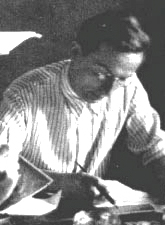Rudolf Arnheim | |
|---|---|
 Arnheim in the 1950s | |
| Born | July 15, 1904 |
| Died | June 9, 2007 (aged 102) |
| Nationality | German-American |
| Alma mater | University of Berlin |
| Known for | Formalist film theory |
| Scientific career | |
| Fields | Film theorist, psychologist |
| Doctoral advisor | Max Wertheimer |
| Other academic advisors | Wolfgang Köhler Kurt Lewin |
Rudolf Arnheim (July 15, 1904 – June 9, 2007) was a German-born writer, art and film theorist, and perceptual psychologist. He learned Gestalt psychology from studying under Max Wertheimer and Wolfgang Köhler at the University of Berlin and applied it to art.[1]
His magnum opus was his book Art and Visual Perception: A Psychology of the Creative Eye (1954). Other major books by Arnheim have included Visual Thinking (1969), and The Power of the Center: A Study of Composition in the Visual Arts (1982). Art and Visual Perception was revised, enlarged and published as a new version in 1974, and it has been translated into fourteen languages. He lived in Germany, Italy, England, and the U.S., where he taught at Sarah Lawrence College, Harvard University, and the University of Michigan.[1]
In Art and Visual Perception, he tried to use science to better understand art. In his later book Visual Thinking (1969), Arnheim critiqued the assumption that language goes before perception. For Arnheim, the only access to reality we have is through our senses. Arnheim argued that perception is strongly identified with thinking, and that artistic expression is another way of reasoning. In The Power of the Center, Arnheim addressed the interaction of art and architecture on concentric and grid spatial patterns. He argued that form and content are indivisible, and that the patterns created by artists reveal the nature of human experience.
- ^ a b The Intelligence of Vision: An Interview with Rudolf Arnheim. cabinetmagazine.org.